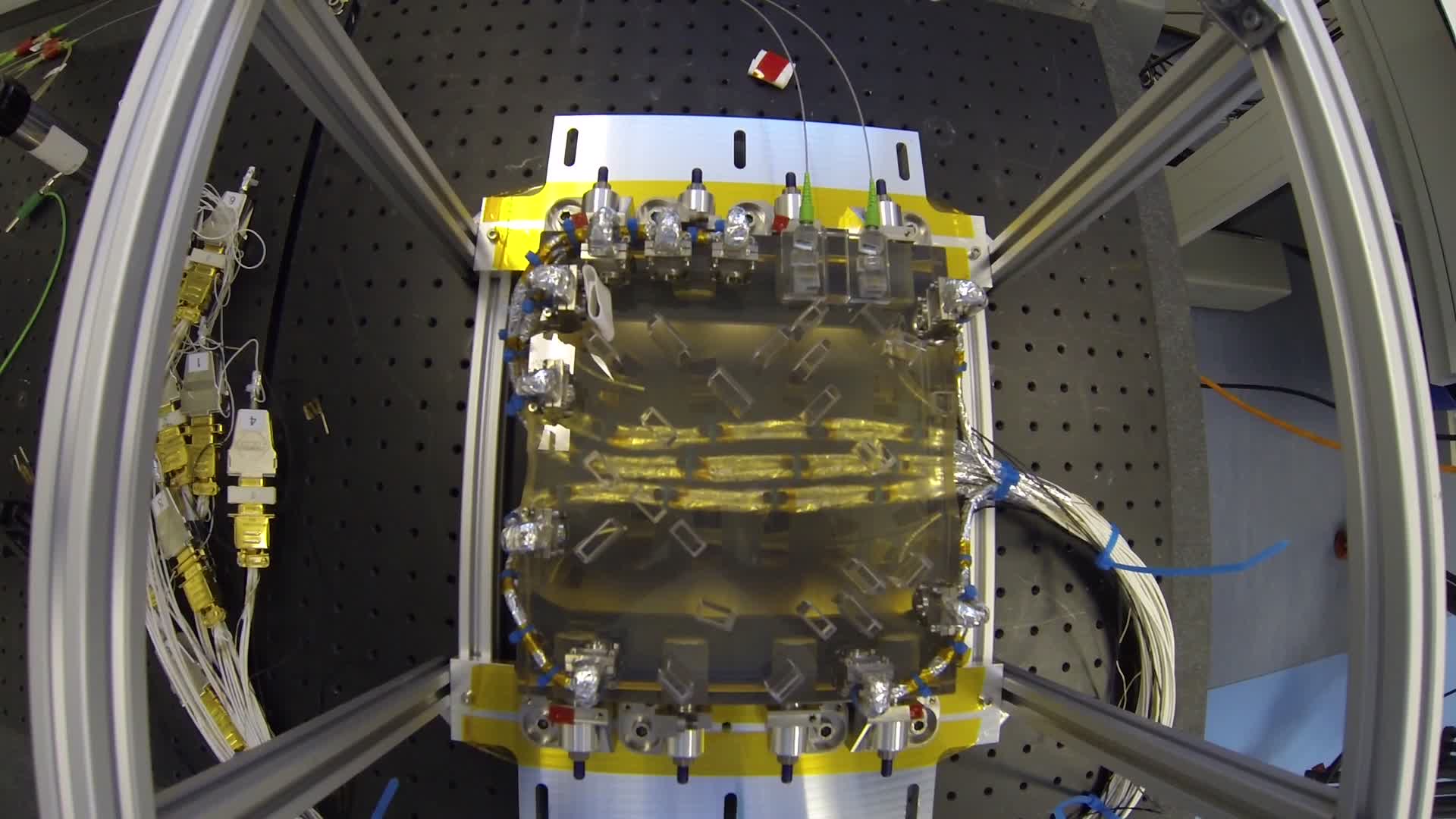Ready for launch The heart of space mission LISA Pathfinder was successfully tested [NOT TRANSLATED]

LISA Pathfinder is
an ESA technology test mission that aims to prove essential key technologies for future space-based gravitational-wave observatories, which cannot be tested on Earth, but only in space. For this purpose, one laser arm of a planned large gravitational wave mission is reduced from millions of kilometres to 40 cm to fit into a single spacecraft. The optical bench tested at the IGR in Glasgow is the heart of LPF. It is now on its way to Astrium Germany for further integration into the LISA Pathfinder Technology Package. At Astrium the optical bench has to undergo health checks of the photodiodes that turn the laser beams into electrical signals, and also micron-level measurement of the beam positions on the photodiodes – a very strong indicator that the bench has survived transit unchanged.
Paving the way
LISA Pathfinder is paving the way for a large-scale space mission designed to detect one of the most elusive phenomena in astronomy – gravitational waves. Extreme precision is required to detect the tiny ripples in the fabric of space and time predicted by Albert Einstein. A direct detection of gravitational waves will add a new sense to our perception of the Universe: for the first time we will be able to LISTEN to the Universe because gravitational waves are similar to sound waves. Hence gravitational wave astronomy will complement our understanding of the Universe and its evolution. Gravitational waves measured by a large mission in space will allow us to e.g. trace the formation, growth, and merger history of massive black holes. Also it will enable us to confront General Relativity with observations, and it will probe new physics and cosmology with gravitational waves.
International collaboration
LPF is an ESA led mission. It involves European space companies and research institutes from France, Germany, Italy, The Netherlands, Spain, Switzerland and UK and the US space agency NASA.
The concept and details of the optical system for LISA Pathfinder have been developed at the Max Planck Institute for Gravitational Physics (Albert Einstein Institute) in Hanover, Germany. Its director Karsten Danzmann is Co-Principal Investigator of the mission and shares the scientific leadership with Stefano Vitale, University of Trento, Italy.
The Instituto de Ciencias del Espacio (CSIC-IEEC), through its group of Gravitational Wave Astronomy-LISA, has played a key role in LISA PathFinder. In collaboration with the local industry the group has design and built the Data Management Unit (DMU), the computer that controls the suit of experiments on board LISA Pathfinder. The group has also contributed with the diagnostics subsystem, a set of high sensitivity sensors for thermal and magnetic control and a radiation monitor for ionized cosmic particles.
The Future
ESA has recently published a call for White Papers describing science themes for the next large ESA missions L2 and L3 to be launched in 2028 and 2034. On 24 May 2013 the eLISA Consortium submitted a White Paper to ESA describing the science case for the eLISA mission: The Gravitational Universe.
The eLISA consortium, a self-funded and independent collaboration of scientists from Denmark, France, Germany, Italy, Netherlands, Spain, Switzerland and the UK is convinced that a spaceborne low-frequency gravitational wave observatory to be launched in 2028 is the ideal tool to make progress in our understanding of the Universe.
Images
optical_bench
Figure 1: Optic Bench del LISA Pathfinder- Credit: Paul Gavin/IGR/AEI/Milde Science Communication
contaminant_test
Figure 2: Examining the optical bench for contamination. – Credit: Paul Gavin/IGR/AEI/Milde Science Communication
alignment_test
Figure 3: Rechecking the precise placement of the mirrors and other elements after the last round of thermal tests on the LISA Pathfinder optical bench.- Credit: Paul Gavin/IGR/AEI/Milde Science Communication
PRESS RELEASE (PDF)
For further information
Website de LISA/LPF:
http://www.elisa-ngo.org/articles/lisa-pathfinder
http://support.elisascience.org/
Website of the LISA – Gravitational Waves Astronomy Group at the Institute of Space Sciences http://gwart.ice.csic.es
Max Planck Institute for Gravitational Physics website: http://www.aei.mpg.de/hannover-en/66-contemporaryIssues/home/index.php
ESA website: http://www.esa.int/Our_Activities/Space_Science/LISA_Pathfinder_overview
UK Space Agency website: http://www.bis.gov.uk/ukspaceagency/missions/lisa-pathfinder-developing-a-gravitational-wave-detector
Contact Spain
Dr. Carlos F. Sopuerta
Institut de Ciències de l’Espai (CSIC-IEEC)
Campus UAB, Facultat de Ciències
Edifici C5, parells, 2a planta
08193 Bellaterra (Barcelona), Spain
Tel: +34 93 5868040 / 644004636
Email: sopuerta@ieec.uab.es
http://gwart.ice.csic.es
Susanne Milde, Milde Science Communication
Tel: +49 (0)331 583 93 55
Email: milde@mildemarketing.de
Alina Hirschmann, Comunicació Científica
Institut d’Estudis Espacials de Catalunya (IEEC)
Tel: +34 93 581 4779
Email: alina@ieec.cat [NOT TRANSLATED]
